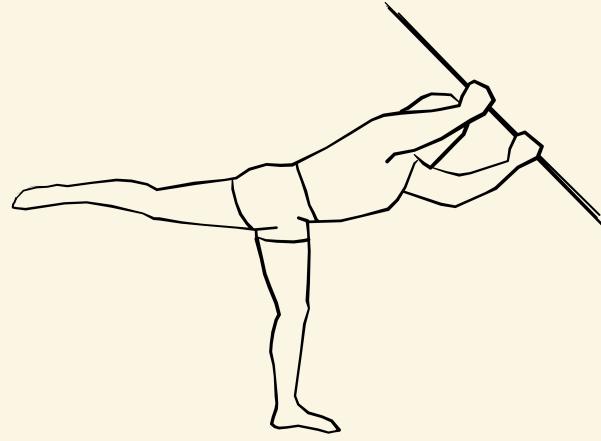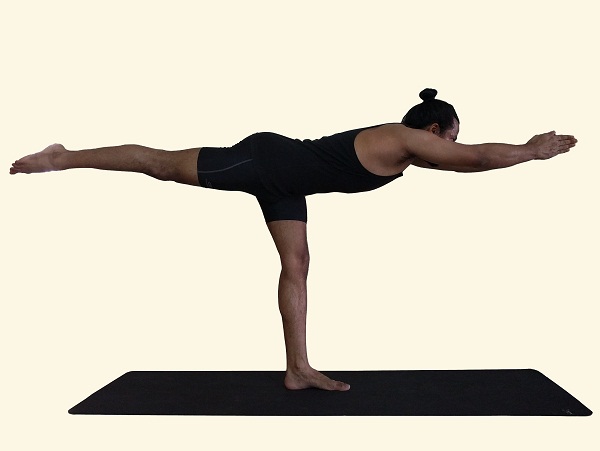To be in sync with what we are talking about please read about the other two posts on warrior-1 and warrior-2
Vir-bhadra-asana 3 The gracious warrior 3 (vir- courageous, warrior; bhadra- gracious)
The martial arts equivalent of this pose is a warrior holding a spear with both hands attacking by lifting one leg in the air to transfer the weight/power to the spear (see the sketch below)

The intention behind the pose
The third in the warrior series is a balancing pose working on the stabilizer’s muscles. It teaches us to be balanced/stabilized while responding to a situation. Situations might be difficult but the more you are able to maintain your cool, the better you can respond.
Balance is the key. Our ideas, emotions, desires, and addictions might make us lean in one direction, and at those times we need our awareness to regulate them and bring us back to a balanced position.
We have talked a lot about the warrior within and our warrior spirit in this post as well as Warrior-1 and Warrior-2, now let’s talk about Virbhadra the warrior on whom these postures are named
The story (we will try to keep the story short as there are too many names involved and you might get lost):
Sati King Daksha’s daughter loved and married Shiva without her dad’s consent. Shiva being an ascetic was not liked by the King. After the marriage, Sati and Shiva were generally not invited to any ceremonies or celebrations in Daksha’s kingdom. Once there was a very grand fire ceremony and a lot of people were invited except for Sati and Shiva. Sati had a lot of affection for her parents and was overpowered by this. Even though she was not invited she went to meet her parents. Daksha insulted her and her husband in front of all the guests. Bruised and broken by this insult she set herself ablaze and died.
After hearing about this incident Shiva became angry, he threw a lock of his hair to the ground, Virbhadra and Bhadrakali (a form of Shakti, Devi who provided Virbhadra the power) were born out of it. After a fierce battle, Virbhadra destroyed the ceremony, killed a lot of the guests, and finally beheaded Daksha.
The deeper meaning of the story
There is always a deeper meaning to these stories, it’s a story of a normal human. People will make fun of you, will bully you, now it’s up to you how you handle the situation, you can either become depressed and frightened or run away and hide from the situation. These situations are telling you about the aspects within that you might be lacking. Rather than closing yourself up, empower yourself with the skill and knowledge to tackle the situation. It’s not about fighting people or beating them up, it’s about creating that energy and intellect within which is confident enough to tackle any situation. It’s about emitting such energy and having such an aura around you that no one can mess with you if they have negative intentions.
The feeling of worthlessness makes you bruised and broken, rather than getting absorbed by such feelings and the suggestions that your mind is making (thoughts like – I am no good, I can’t do it, etc) grow the Virbhadra within to take actions, to change the things which you can.
Our mind and body are connected, an emotion or thought can change your body position (eg. the fear or sadness might close you up moving the shoulders forward) similarly practicing some Asanas can grow certain qualities in the mind by aligning our body

Steps
- Begin standing in Tadasana (mountain pose) with your feet hip-distance apart and your arms at your sides.
- Increase the gap between your feet to about 3 to 4 ft. Pivot your right foot out 90 degrees and your left foot inward at a 45 angle. Point your pelvis and torso in the same direction as your right toes.
- Bend your right knee over your right ankle so your shin is perpendicular to the floor. Raise your arms overhead with your palms facing each other.
- Press your weight into your right foot. Inhale lift your left leg as you lower your torso, bringing your body parallel to the ground. Your arms, still extended, will now reach forward.
- Extend your left foot and point your left toes.
- Keep the muscles of both legs actively engaged. Straighten your right leg as you continue to lift the left, but do not lock your knees.
- Work toward bringing your arms, torso, hips, and raised leg parallel to the floor. (You may need to lower the hip of your left leg slightly in order to bring your hips parallel to your mat.)
- Stretch your body from your fingertips all the way through your lifted toes
- Gaze at the floor a few feet in front of your body.
- Hold the pose for a few breaths. To release, exhale as you softly lower your left foot back to the floor. Lower your arms and step forward into Mountain Pose. Repeat the pose for the same amount of time on the opposite side.
**Beginner tips – Practice it with the help of a partner or face the wall so that your fingers just reach the wall.
Benefits
- Strengthens the whole back side of the body, ( shoulders, hamstrings, calves, ankles, and back)
- Tones and strengthens the abdominal muscles.
- Improves balance, posture, and full-body coordination
- Improves concentration
Contraindications/ Precautions
- Recent or chronic injury to the hips, and knees.
- High blood pressure
Looking for other postures? Check our Posture library.